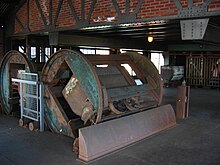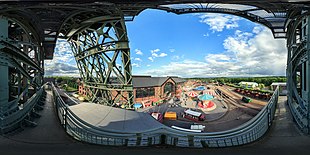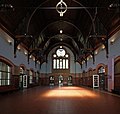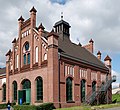Zollern colliery
| Zollern colliery | |||
|---|---|---|---|
| General information about the mine | |||
| Zeche Zollern II / IV (2019) | |||
| Information about the mining company | |||
| Operating company | Gelsenkirchener Bergwerks-AG | ||
| Start of operation | 1899 | ||
| End of operation | 1955 | ||
| Successor use | museum | ||
| Funded raw materials | |||
| Degradation of | Hard coal | ||
| Geographical location | |||
| Coordinates | 51 ° 31 '4.1 " N , 7 ° 20' 4.7" E | ||
|
|||
| Location | Bövinghausen | ||
| local community | Dortmund | ||
| Independent city ( NUTS3 ) | Dortmund | ||
| country | State of North Rhine-Westphalia | ||
| Country | Germany | ||
| District | Ruhr area | ||

The Zeche Zollern is a disused hard coal mine in the northwest of the city of Dortmund , in the Bövinghausen district . It consists of two shafts that were connected underground: the shafts I / III (i.e. shafts I and III) in Kirchlinde and the shafts II / IV in Bövinghausen.
The Zeche Zollern II / IV is today one of eight museum locations of the decentralized LWL industrial museum , which is also located here. The colliery is an anchor point of the Route of Industrial Culture in the Ruhr Area and the European Route of Industrial Culture (ERIH).
Not to be confused with the Zeche Zollverein .
history
Zollern 2/4 was built between 1898 and 1904 as a model mine of the Gelsenkirchener Bergwerks-AG (GBAG) under the influence of its director Emil Kirdorf . The architecture and technology of the mine should express economic potential and modernity. In 1899, at a depth of 139 m at shaft 2, the President seam was encountered . In the first stage of the shaft was to 3. sole in 282 m depth drilled . In 1921 and 1942 the shaft was expanded to a final depth of 490 m. Shaft 4 was sunk to the third level in 1900 and served as a weather shaft . There was a breakthrough to the Zollern 1 and 3 shafts. Until the First World War, the third level was the main source ; then the production shifted to the 4th level (366 m depth). Despite the modernity of the system, there were deficiencies in the daytime systems . No car circulation was possible in the short shaft hall, inadequate processing systems for separating and processing the coal. In 1908, underground locomotive mining was introduced. The destruction of the operating facilities in the 2/4 mine during the Second World War was comparatively low.
As early as the end of the 1920s, the then owner, Vereinigte Stahlwerke AG, had plans to combine the promotion of the Zollern 1/3, Zollern 2/4, Germania 1/4 and Germania 2/3 pits. A central conveyor system was to be set up with the promotion to the 6th level. However, it was not until December 1939 that construction work began on the Germania 2/3 site; the preliminary final depth was reached on March 17, 1942 with a depth of 649.5 m. The original plan to set up a ski subsidy was given up due to the shortage economy caused by the war and a rack subsidy was provided. Bunkers and blind shafts had to be created to connect the mine workings to the central conveyor shaft . From 1958 the 7th level was driven at a depth of −683 m above sea level.
Forced laborers were also employed in the mine until 1945 .
In 1951 the lamp room was rebuilt on Zollern 2/4 and a shower room was built on the Kaue . The coal production on the plant was stopped in 1955. At the end of the 1950s, systems were gradually demolished (cable car, mountain crushing system, shaft building ) or only kept available as reserve capacities (compressed air supply).
In 1965, the Germania / Zollern composite mine had to withdraw production; the board of directors of Dortmunder Bergbau AG decided to shut down the Zollern 2/4 mine and to move the miners to the other subsystems. The shafts Zollern 2 and 4 were in 1967 and 1966 filled . The daytime systems remained with GBAG until they were taken over by RAG . The Germania central shaft system was shut down in 1971. The cause of the closure was the unfavorable deposit conditions , which prevented the mechanization of mining . In addition, the mine’s developed coal reserves were low and this would have required a great deal of effort to develop further reserves.
In 1904, a coking plant was built on the Zollern 2/4 colliery, but it was only in operation until 1918.
Buildings / colliery facilities
Zollern is one of the most architecturally remarkable mining facilities in the Ruhr area . There is a large, tree-lined square behind the mine gate. The front area of the day facilities is reminiscent of a three-wing baroque palace complex in the style of historicism at the turn of the century. The architecture is based on the ideal of the north German brick Gothic , the red brick masonry is loosened up by shaped stones, decorative associations and light plaster fields. These buildings were designed by the architect Paul Knobbe (1867–1956), who planned a large part of all new GBAG buildings at that time. The interior of the wages hall is also lavishly designed, and after a long period of misuse, it was carefully restored only a few years ago - like all buildings.
In fact, the mine had remained without major changes for decades. Only individual parts of the system that were worn out or no longer needed were broken off, scrapped or replaced. Including the original headframes, which, however, were replaced between 1986 and 1988 by two identical frames from other mines. The scaffolding above the Zollern II shaft comes from the Wilhelmine Victoria colliery in Gelsenkirchen, the one above the Zollern IV shaft from Frederick the Great in Herne.
At the end of the 1960s, when a complete demolition of the plant was to be feared after the shutdown, the most spectacular building of the whole plant finally caught the attention of the early industrial monument preservation : the machine hall.
The machine shop
At the time, the central machine hall of the colliery was no longer built as a massive construction (as initially planned by Knobbe), but in the hope of faster completion as an iron framework construction filled with brick. The model was the exhibition hall of the Gutehoffnungshütte at the Rheinisch-Westphalian industrial and trade exhibition in Düsseldorf in 1902 , in which the electric hoisting machine for shaft II (before its final assembly in Bövinghausen) was exhibited. As with the Düsseldorf hall of the Berlin architect saw Bruno Möhring (1863-1929) for the decoration of the machine shop with details in Art Nouveau forms (similar to when the peak of the main entrance with colored glazing and a curved canopy Paris metro stations by Hector Guimard ) could apply. The canopy was probably torn off after damage in the 1930s, but other details still cast a spell over the viewer today.
Even if the Art Nouveau was rather unusual for an industrial building overall, there were or still are some examples of its use in connection with buildings of electricity, e.g. B. the Heimbach hydropower plant in the Eifel, or modern iron structures, e.g. B. on the Berlin subway. The machine hall fulfills both criteria: it was a modern iron construction at the time, and it housed advanced electrical engineering when other mines were still working without electricity.
The machine hall has been extensively renovated since 2009. A storm damage to the roof of the machine hall in November 2010 delayed the completion date of the renovation work. The machine hall has been open to the public since September 11, 2016.
The technology
In addition to the architectural value of the facility, the technical equipment should also be emphasized. In the machine hall, the most important large technical devices such as hoisting machines, compressors and converters have largely been preserved in their original condition. The fact that all essential machines, including the hoisting machines , were electrically operated on Zollern for the first time is of technical historical importance . The electricity was originally generated in our own generators, which are no longer available.
Great emphasis was also placed on representation when designing the technical systems. Obvious examples are the magnificent marble control panel with its multitude of original instruments or the large Art Nouveau clock in the machine shop.
Air compressor in the machine shop
Landwehr Colony
Immediately in front of the colliery, the Landwehr colony - also designed by Paul Knobbe - was built by 1904 . It consists of a director's villa, eight Steiger houses and 23 workers' houses. The buildings - like the front part of the colliery - were designed in the style of historicism and underline the ensemble character of the entire complex. Like the colliery, they are registered as architectural monuments in the monuments list of the city of Dortmund .
The museum
Thanks to the initiative of Hans P. Koellmann, the machine hall was not demolished in 1969 as planned, but was instead placed under monument protection as the first industrial building in Germany and was initially looked after by the German Mining Museum in Bochum. In 1981, the Regional Association of Westphalia-Lippe integrated the colliery into the decentralized Westphalian Industrial Museum. Little by little, the surrounding buildings were restored and made accessible to the public. In addition to the impressive buildings, the outdoor facilities are also part of the museum. The coal loading station, the former colliery station and an accessible headframe are among the attractions. The interior of the machine hall was extensively renovated by late autumn 2012.
In the area of the former colliery station and the adjoining outdoor area there is an extensive collection of railway vehicles, most of which come from former works railways of the mining industry. For example, the steam locomotive “97” of the former narrow-gauge factory railway of the Westfalenhütte can be found here .
In 1999 the permanent exhibition Musterzeche was opened. In this, the social and cultural history of the Ruhr area is clearly presented for both adults and children. The exhibition focuses on the training system in the Ruhr mining industry, the development of industrial hygiene and health systems, and efforts to reduce work-related accidents.
There are special tours for children on the museum grounds. A children's playground completed in 2006 completes the offer for children.
The premises of the museum are increasingly being used as an event and conference location and can be rented. Among other things, the machine hall was already a venue for the Ruhr Piano Festival . The foyer of the administration building with its ornamental staircase is often used for weddings.
The “Pferdestall” restaurant on the museum grounds takes care of your physical well-being.
Events
The Zeche Zollern has been used as an event location for productions from the region for many years. One of the best-known is the vulture evening organized annually by the independent theater Fletch Bizzel , a parody of the ceremonial meetings taking place in the Rhenish Carnival .
Others
On November 6, 1987, a stamp with the motif of the colliery appeared as part of the Sights stamp series. The stamp has a value of 80 pfennigs. The stamp was issued by both the Deutsche Bundespost and the Deutsche Bundespost Berlin.
Coordinates
- Bay 1: 51 ° 31 ′ 13.1 ″ N , 7 ° 22 ′ 10.6 ″ E
- Shaft 2: 51 ° 31 ′ 4.1 ″ N , 7 ° 20 ′ 4.7 ″ E , with shaft structure from the Wilhelmine Victoria 1 mine
- Bay 3: 51 ° 31 ′ 13.5 ″ N , 7 ° 22 ′ 12.1 ″ E
- Shaft 4: 51 ° 31 ′ 6.4 ″ N , 7 ° 20 ′ 6.8 ″ E , with the shaft frame of the Friedrich der Große 3 colliery
![]() Map with all coordinates of the shafts: OSM
Map with all coordinates of the shafts: OSM
literature
- Hubertus Kaffanke, Alfred Franke: Zollern-Germania. The development of four mines in the west of Dortmund to the central shaft system 1850–1971. (= Landschaftsverband Westfalen-Lippe, Westfälisches Industriemuseum, Writings Volume 32.) Klartext Verlag, Essen 1999, ISBN 3-88474-809-2 .
- Eberhard G. Neumann: Zeche Zollern 2/4 Dortmund. (= Great Architectural Monuments, Issue 299.) Deutscher Kunstverlag, Munich, Berlin ...
- Katrin Holthaus: Architectural Guide Zeche Zollern 2/4. Klartext Verlag, Essen 2004.
- Olge Dommer, Dagmar Kift: No man's years. Youth in the Ruhr mining industry 1898–1961. The example of Zeche Zollern II / IV. Essen 1998.
- Frank Günther et al .: A castle of work. Provisional guide to the Zeche Zollern II / IV. Westfälisches Industriemuseum, Dortmund 1996, 2nd edition 1997.
- Dagmar Kift: Musterzeche Zollern II / IV. Museum for the social and cultural history of the Ruhr mining industry. Museum guide. Essen 1999.
- Wilhelm and Gertrude Hermann: The old mines on the Ruhr . In: The Blue Books . 6th edition, expanded to include a digression according to p. 216 and updated in energy policy parts, the 5th edition, completely revised. u. extended edition. Langewiesche publishing house , Königstein im Taunus 2008, ISBN 978-3-7845-6994-9 , especially pp. 111–121.
- Torsten Meyer: Technology, Work and the Environment in History . Günter Bayerl on his 60th birthday. Ed .: Marcus Popplow. Waxmann, Münster / New York / Munich / Berlin 2006, ISBN 978-3-8309-1685-7 , Rescue of the machine hall 1969, p. 407 ff . ( Excerpt [accessed on July 21, 2019]).
Web links
- Description of this attraction and anchor point as part of the Route of Industrial Heritage
- Zollern colliery. In: lwl.org. LWL-Industriemuseum -, accessed on July 21, 2019 .
- Zollern colliery. Media database. In: lwl.org. LWL media center for Westphalia, accessed on July 21, 2019 .
- Chronicle and reconstruction of the mine as part of the project Zeitreise Ruhr
- Germania. In: ruhrzechenaus.de. Retrieved July 21, 2019 .
- Mine accident memorial. Mine accident on Zollern, May 22, 1898. In: olleroh.de. Retrieved July 21, 2019 .
Individual evidence
- ↑ The exhibition “Forced Labor. The Germans, the Forced Laborers and the War ”in the LWL-Industriemuseum - Zeche Zollern in Dortmund ( Memento of the original from December 4, 2015 in the Internet Archive ) Info: The archive link was inserted automatically and not yet checked. Please check the original and archive link according to the instructions and then remove this notice.
- ↑ LWL-Industriemuseum Zeche Zollern: themed tours in the machine hall
- ↑ No. A 0373. List of monuments of the city of Dortmund. (PDF) (No longer available online.) In: dortmund.de - Das Dortmunder Stadtportal. Monument Authority of the City of Dortmund, April 14, 2014, archived from the original on September 15, 2014 ; accessed on June 13, 2014 (size: 180 kB). Info: The archive link was inserted automatically and has not yet been checked. Please check the original and archive link according to the instructions and then remove this notice.

























